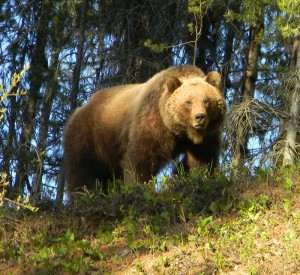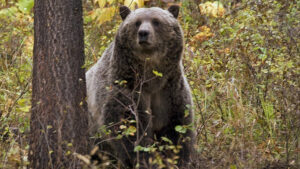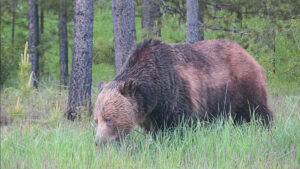
A summary of the well-attended (at least 40-50 people) October 18 bear meeting at Sondreson Hall…
The presenters from Montana Fish, Wildlife and Parks were Wildlife Management Specialist Erik Wenum of the Wildlife-Human Attack Response Team (WHART) and Justine Vallieres, Region 1 Bear Manager.
On October 1, a grizzly bear, apparently chasing a dog, encountered and mauled a woman at the “Bubble-Ups” near Trail Creek Road. Her husband drove it off with bear spray.
The next day, a dog went missing from a residence a few miles away from the Trail Creek incident. A neighbor’s photo showed the same bear in the yard. The dog never returned.
Another similar incident occurred on October 8 when a dog was attacked and killed at a cabin on Trail Creek Road. The owner shot at and injured the bear, which eventually retreated into the woods. Despite setting a trap and deploying a considerable array of cameras, FWP has seen no sign of the bear since it fled. Area residents were asked to keep an eye out for signs of scavenging activity, such as mobs of noisy birds.
Through DNA analysis, FWP determined that the same bear, a male at least 9 years old, was involved in all three incidents. The DNA data used for the match was from a hair sample obtained in Canada.
Both presenters pointed out that a grizzly bear deliberately attacking a dog is extremely unusual behavior. There have been a couple of incidents over the past few decades where a dog was killed accidentally because it was tethered between a grizzly and a food source, but neither had ever heard of an unprovoked attack.
About a month earlier, a man killed himself in the area near Tepee Lake. A bear discovered and consumed the better part of his remains. DNA analysis showed that this was not the same bear as the culprit in the Trail Creek incidents. It was a female grizzly that just happened to come across a food source. It is not a problem bear.
So, the female grizzly was just being a bear and is of little interest. If FWP happens to capture the aggressive Trail Creek bear, it will almost certainly be put down. There has been no sign of that bear since it was injured on October 8.
Incidentally, all this detective work is expensive. High priority DNA analysis costs FWP $1200 per sample.
A great deal of the general discussion covered items familiar to anyone who has been on the North Fork for any length of time: removing or securing bear attractants, being generally bear aware, and the importance of carrying and knowing how to use bear spray. One new item (to me, at least) was the importance of agitating bear spray periodically. Erik Wenum explained that the ingredients can separate out if the spray lays too long in one position. He likened it to storing unhomogenized peanut butter where the oil eventually rises to the top. He suggested at least shaking up your bear spray before you go someplace with it. Also, pay attention to the expiration date!
And perhaps the most important point: Justine asked that people not delay notifying her when they have a bear problem. The sooner she knows about it, the more likely it is that she can intervene without having to take drastic measures like putting the bear down.
 Justine Vallieres and Erik Wenum from FWP will be at the Community Hall this Wednesday, the 18th, at 1600. They will give an update on the recent bear incidents and to answer any questions from the community. All are welcome to attend.
Justine Vallieres and Erik Wenum from FWP will be at the Community Hall this Wednesday, the 18th, at 1600. They will give an update on the recent bear incidents and to answer any questions from the community. All are welcome to attend. 
